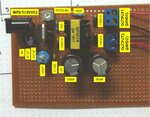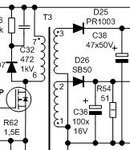peggy
Junior Member level 1
hi murali_dece,
Thank you very much for helpful and useful advice.
I just finish my assembly with all components and found out the output voltage is very unstable(voltage flow between 23.7VDC to 24.3VDC). I have make the change to input voltage became 12VDC 2A, so this is the main reason that can't generate stable output voltage?(since i need to generate 24VDC 1A instead 0.5mA).
what can i do to make the output voltage became stable(or maybe just change the capacitor from 560uF to 1200uF)?
please advice. Thank you.

Thank you very much for helpful and useful advice.
I just finish my assembly with all components and found out the output voltage is very unstable(voltage flow between 23.7VDC to 24.3VDC). I have make the change to input voltage became 12VDC 2A, so this is the main reason that can't generate stable output voltage?(since i need to generate 24VDC 1A instead 0.5mA).
what can i do to make the output voltage became stable(or maybe just change the capacitor from 560uF to 1200uF)?
please advice. Thank you.





